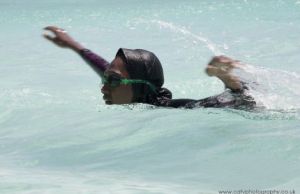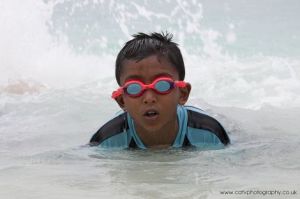Isha Afeef is Social and Environmental Responsibility Fund Manager at Soneva Fushi. She is 20 years old and grew up in Male. While supporting the Learn to Swim programme, an initiative born out of the SLOW LIFE Symposium, she has learnt to swim herself and has been snorkeling for the first time.
If you’d asked me about the Swim Camp two weeks ago, what I could have told you is that it is an initiative by Soneva Fushi and Jon Bowermaster to teach local kids who live 1m above sea level how to love the water around them by learning to swim. Today, this still holds true, but starting the programme has unfolded many sides which we weren’t expecting – the enthusiasm of the parents and teachers, the boldness and vulnerability of the kids, and the love and gratitude from the island of Eydhafushi to all those involved in the programme.
While learning to swim ought to be a necessity on such low-lying coastal islands, it is often neglected while academics and urbanization are prioritized. As we grow to become more ‘educated’, the more we appear to withdraw from the beckoning ocean and into the humdrum of daily life. While many boys eventually find their way to swimming in the sea, the girls and ladies never hardly dare venture any deeper than where their feet would touch the bottom of the sea – myself included. As disgraceful as it is that I’ve lived and loved by the sea for twenty years, the ocean, with its many moods and facades, still terrifies me.
And that was why being part of the programme has been and continues to be an insightful experience. When I’m in the water holding the hand of a young girl who doesn’t even dare put her head in the water, I understand that crippling fear that makes it hard to let go. ‘Vaagi dhookollaa’, we keep saying to them, but there are still some who lie stiff as a board, afraid of letting go. It’s so hard to let go of your modicum of control when you aren’t confident that you can move through the water, be able to control yourself so that you don’t drown, or sink, or get bitten by an eel or a twig that looks like a eel. It’s not still water – anything that might not have been there might come to be, when the tides washes it in.
So it comes without a surprise that the past week has been the most that I’ve ever spent in the water, coming out at the end of the day a shade or two darker than I went in, but feeling so much lighter on the inside, because I’m growing to be comfortable in the water. And I can feel the kids learning to let go too, and while none of us expect a miracle to happen overnight, these kids have hope. At eight, they’re already so lucky to have a group of people dedicated to teaching them how to swim – so when they’re twenty, they won’t be going through what I am. When they’re twenty, they will have snorkeled and seen the beautiful gardens enriching our reefs, learnt to swim with the dolphins, to come close to sharks, and live knowing the beauty of our oceans.
Originally posted by the SLOW LIFE Symposium.
Related articles:
Learning to Swim the Maldivian Way
Commitments conclude the 2013 SLOW LIFE Symposium
2013 SLOW LIFE Symposium – Positive Change & ACTION
Coral Restoration 26 Months
The Boy and the Coconut


